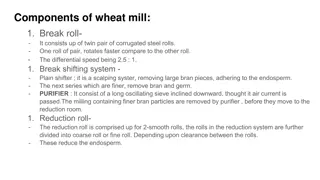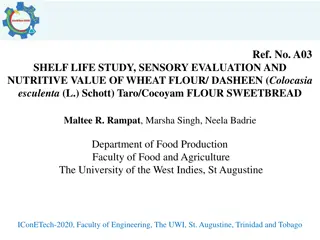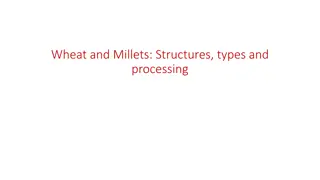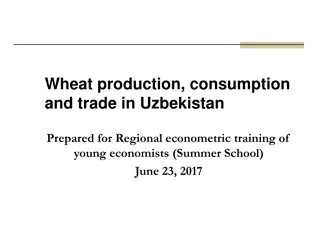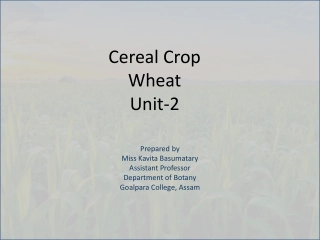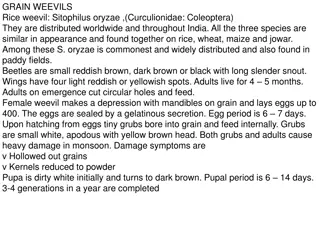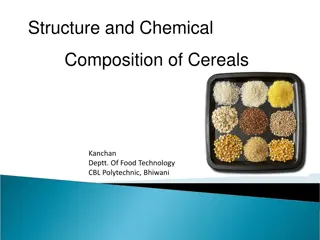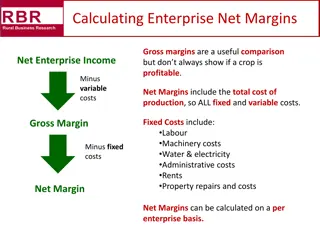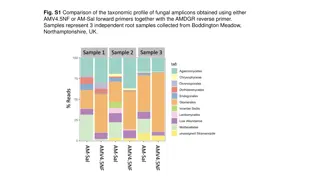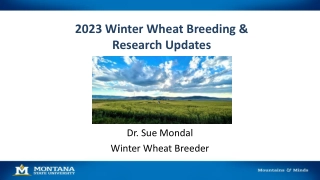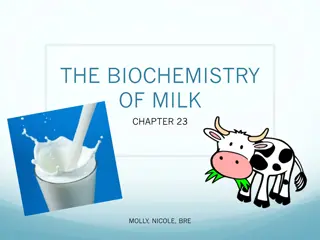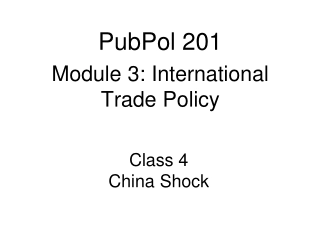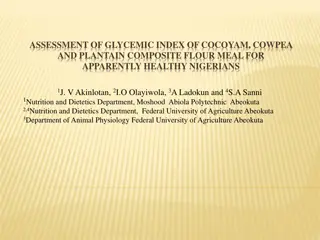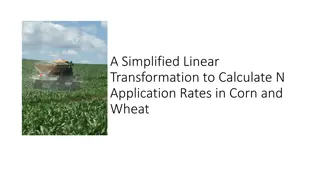Understanding Wheat Flour Fortification and Processing Technology in China
This content discusses the history, technology, and systems involved in fortified flour in China. It covers the calculation methods for nutritional efficiency of nutrients, including concepts like Dietary Reference Intakes and Recommended Nutrient Intake. Safety measures, such as Adequate Intake and Tolerable Upper Intake Level, are also highlighted in the context of food fortification. Theoretical bases and distribution models for fortification are explained to ensure the health and well-being of the population.
Download Presentation

Please find below an Image/Link to download the presentation.
The content on the website is provided AS IS for your information and personal use only. It may not be sold, licensed, or shared on other websites without obtaining consent from the author. Download presentation by click this link. If you encounter any issues during the download, it is possible that the publisher has removed the file from their server.
E N D
Presentation Transcript
China Experience in Fortified Flour Standard- and administrative system- based flour fortification system 02 01 The history of flour fortification technology in China Flour fortification and fortification substances common in different countries 03 04 How to understand flour fortification 05 06 Quality safety assurance system Wheat flour fortification & processing technology
5 Part Wheat Flour Fortification & Processing Technology
5.1 Calculation method for nutritional efficiency of nutrients Basis Concept Dietary Reference Intakes (DRIs) Estimated Average Requirement (EAR): the nutrient intake level established based on research data on individual requirements; such intake level can meet 50% individual requirements of population of a particular gender, age, and physiological status but cannot meet the requirements for such nutrient for other 50% of the population. Recommended Nutrient Intake (RNI): RNI is the intake level that can meet the individual nutritional requirements of the vast majority (97%-98%) of the population of a particular gender, age and physiological status. RNI = EAR+2SD
5.1 Calculation method for nutritional efficiency of nutrients Basis Concept Dietary Reference Intakes (DRIs) Adequate Intake (AI) :When research data on individual requirements is insufficient to calculate EAR and RNI, the intake of certain nutrients of healthy population obtained through observation or experiment; extensive research on the adequate intake is required and a high degree of attention is required for the use of this term. Adequate experimental data and scientific evidence are required to ensure safety. Tolerable upper intake level (UL) is the maximum average daily intake of nutrients. When the intake exceeds the UL, the risk of damage to health increases. There is no sufficient data to determine the UL of certain nutrients, which does not mean that excessive intake causes no potential harm. Prudence and safety are the fundamental principles for fortification and shall be strictly followed.
5.1Calculation method for nutritional efficiency of nutrients Theoretical basis of food fortification EAR RNI Distribution of intake P5 P50 P97.5 RNI (recommended nutrition intakes): daily requirement for 97.5% healthy individuals. EAR: estimated average requirement. RNI=EAR+2SD, where SD of nutrients for general population is 10% of EAR. There is no normal distribution of the intake of iron and other nutrients in the population.
5.1 Calculation method for nutritional efficiency of nutrients Determine food fortification objective: UL > amount of fortification +available intake > EAR WHO recommendation: when the Reach RNI: applies to individual guidance. public health problem of general Reach EAR: applies to large population intervention. nutritional deficiency is solved through food fortification, the Fortification conditions for large population: adequate fortification level shall There is a certain percentage of population with an actual intake of less than EAR. reach 70% of EAR. The percentage Fortification conditions for target population: of population whose intake exceeds There is a certain percentage of population with an intake of less than EAR. the UL shall be kept within 5%.
Calculate the risk of deficiency and excess Percentage of population wheat flour (g/day) Acceptable level after overall consideration Daily consumption of Intake of Vitamin A from a variety of sources ( g/day) Relation between Vitamin A taken in the form of retinol and EAR and UL Before fortificatio n Fortification level 3mg/kg Fortification level 5mg/kg Before fortification Fortification level 3mg/kg Fortification level 5mg/kg Population Prone to Risk of Nutrient Deficiency 5 30 120 210 270 - - - 10 45 160 295 385 - - * 25 120 200 560 800 - * * 50 180 240 780 1140 - * * Population Prone to Risk of Nutrient Excess 75 240 600 1320 1800 * * * 90 300 1000 1900 2500 * * * 95 360 1250 2330 3050 * * + Nutrient deficiency and risk of poisoning 65 0 15 2 8 6 Percentage of female's intake below EAR (%) Percentage of female's intake above the UL (%)
5.1 Calculation method for nutritional efficiency of nutrients Calculation of Utilization Calculation of human body utilization. The human body utilization refers to the bioavailability, namely the percentage of the result obtained from the intake minus the absorption amount in element intake. Extensive basic research in medicine is required to analyze the performance evaluation for all nutrients. The biological potency comparison tables of other countries can also be taken as references. However, in-depth research and analysis of domestic medical teams are required to obtain added value of domestic nutrients after removing influencing factors of different regions under different nutritional conditions.
5.1 Calculation method for nutritional efficiency of nutrients Calculation of Utilization Processing calculation Taking iron for example, the fortified wheat flour sample is made into dilute hydrochloric acid solution after incineration, where iron is present in the form of Fe+3. Fe3+ is reduced to Fe2+ with hydroxylamine hydrochloride. Fe2+ forms stable red compound under the act of phenanthroline at the ph level of 3~9. Iron content is calculated based on the standard curve drawn with the absorbance measured around 510nm. Ten representative samples are taken from each batch of fortified wheat flour, to reflect the uniformity of distribution of each component through the determination of difference of iron content.
Legal limit for fortification level FFL = feasible fortification level; mFL = minimum fortification level (product parameter); TF L = targeted fortification level (product parameter); MFL = maximum fortification level (product parameter); LmL = legal minimum level (legal parameter); MTL = maximum tolerable level (legal parameter). Home minimum level (HmL) is indicated in the above diagram, which may be lower than the LmL due to loss of nutrients stored in the home prior to consumption. HmL is often used to monitor consumer use, coverage, and consumption of fortified foods. Amount of fortification substances + local content of carrier
Basis for Calculation of Amount of Safe Fortification Substances in Foods Technical limit: the amount of fortification substances that do not affect sensory characteristics, physical properties and processing quality of food. 3 Feasible fortification level (FFL): the lowest of safety limit, cost limit and technical limit. Targeted fortification level: FFL + intrinsic content of nutrients in food. Minimum fortification level (mFL, mg/kg)=targeted fortification level Maximum fortification level(MFL, mg/kg)=targeted fortification level [1 - (2 [1 + (2 CV (%/100)] CV (%/100)] Consider from nutrition labeling and regulation This is related to the mixing uniformity. In general, the mixing uniformity during the mixing of liquid foods is 10%. The mixing uniformity of fine solids (cereal flour) during mixing of solids is 10%-25%. The mixing uniformity of non-fine solids is 30%-50%. The uniformity of fortified flour is prescribed to be less than 10% in China.
Calculation of amount of safe fortification substances in foods [UL(mg)- total intake of micronutrients in diets and dietary supplements (mg)] 1 = Safe limit (mg/kg) [95% of food consumption (kg); Safe limit of staple food (or energy-giving food) UL-( intake of certain micronutrient in diet of supplements) 95% of energy intake amount of fortification substances in food amount = percentage of fortified food to energy of food that can be fortified Mean of tracer: 2 Computational formula for uniformity Standard deviation of tracer: Blending uniformity of tracer:
5.2 Technical Specifications for Nutrient Mixing for Wheat Flour Fortification The basic standard for fortified food in China is GB 14880-2012 which specifies the scope of application and usage amount of all micronutrients, as well as the list of compounds (the list is available in book stores in China) that can be used as fortification substances. Multiple micronutrients are usually fed at the same time for wheat flour fortification. Except for calcium which can be mixed with flour separately, a majority of other micronutrients are fed through the production line in the form special premix during the wheat flour production due to their small usage amount.
Technical Specifications for Nutrient Mixing for Wheat Flour Fortification 5.2 Table A.1 Permitted varieties, range of useaand usage amount of fortification substances Number of food category Fortification substances Food category (name) Usage amount Vitamins 01.01.03 Modified milk Modified milk powder (except milk powder for children and for pregnant women) Modified milk powder (milk powder for children only) Modified milk powder (milk powder for pregnant women only) Vegetable oil 600 g/kg ~1000 g/kg National Standard of the People's Republic of China 3000 g/kg~9000 g/kg 01.03.02 1200 g/kg~7000 g/kg 2000 g/kg~10000 g/kg 02.01.01.01 4000 g/kg 8000 g/kg 02.02.01.02 Margarine and similar products 4000 g/kg 8000 g/kg 03.01 Ice cream 600 g/kg 1200 g/kg Vitamin A 04.04.01.07 04.04.01.08 06.02.01 06.03.01 06.06 07.02.02 Bean flour and soya-bean milk powder Soybean milk Rice Wheat flour Ready-to-eat cereals, including rolled oatflakes Foreign pastry 3000 g/kg~7000 g/kg 600 g/kg-1400 g/kg 600 g/kg~1200 g/kg 600 g/kg-1200 g/kg 2000 g/kg-6000 g/kg 2330 g/kg 4000 g/kg National Food Safety Standard for the Use of Nutritional Fortification Substances in Foods 07.03 Biscuits 2330 g/kg 4000 g/kg 14.03.01 14.06 16.01 16.06 14.06 01.01.03 Milk containing drink Solid drinks Fruit jelly Puffed food Solid drinks Modified milk Modified milk powder (except milk powder for children and for pregnant women) Modified milk powder (milk powder for children only) Modified milk powder (milk powder for pregnant women only) Margarine and similar products 300 g/kg 1000 g/kg 4000 g/kg~17000 g/kg 600 g/kg-1000 g/kg 600 g/kg~1500 g/kg 3 mg /kg 6mg/kg 10 g/kg 40 g/kg Beta-carotene 63 g/kg 125 g/kg 01.03.02 20 g/kg~112 g/kg 23 g/kg~112 g/kg 02.02.01.02 125 g/kg~156 g/kg Implemented on January 1, 2013 Issued on March 15, 2012 Vitamin D 03.01 Ice cream 10 g/kg-20 g/kg Issued by Ministry of Health of the People's Republic of China 04.04.01.07 04.04.01.08 06.05.02.03 06.06 07.03 Bean flour and soya-bean milk powder Soybean milk Lotus root starch Ready-to-eat cereals, including rolled oatflakes Biscuits 15 g/kg~60 g/kg 3 g/kg~15 g/kg 50 g/kg~100 g/kg 12.5 g/kg 37.5 g/kg 16.7 g/kg~33.3 g/kg 07.05 Other bakery products 10 g/kg~70 g/kg
Appendix B List of Sources of Permissible Compound Fortification Substances The list of sources of permissible compound fortification substances is shown in Table B.1. Table B.1 List of sources of permissible compound fortification substances Fortification substances Retinyl acetate (retinyl acetate A) Retinyl palmitate (Vitamin A palmitate) Alltrans retinol Beta-carotene Beta-carotene Beta-carotene Ergocalciferol (Vitamin D2) Cholecalciferol (Vitamin D3) d- -tocopherol dl- -tocopherol d- -tocopheryl acetate dl- -tocopheryl acetate Mixed tocopherols concentrate Vitamin E calcium succinate d- -tocopheryl acid succinate dl- -tocopheryl acid succinate Vitamin K Phytonadione Thiamin hydrochloride Thiamin mononitrate Riboflavin Riboflavin -5 '-sodium phosphate Pyridoxine hydrochloride Pyridoxal 5'-phosphate Cyanocobalamin Cyanocobalamin hydrochloride Hydroxycobalamin L-ascorbic acid L-calcium ascorbate Vitamin C magnesium phosphate L-sodium ascorbate L-potassium ascorbate L- ascorbate -6- palmitate (Ascorbate palmitate) Nicotinic acid Nicotinamide Folic acid Folic acid (pteroylglutamic acid) D - calcium pantothenate D-sodium pantothenate Source of compound Vitamin A Vitamin D Vitamin E Vitamin B1 Vitamin B2 Vitamin B6 Vitamin B12 Vitamin C Nicotinic acid Pantothenic acid
5.2 Technical Specifications for Nutrient Mixing for Wheat Flour Fortification Nutrient mixture is often designed based on the feeding amount of 50~400g for flour per ton. Nutrient premixes usually contain diluents (e.g. starch, calcium salt, maltodextrin) and glidants (e.g. tricalcium phosphate), to improve fluidity and enhance mixing effect.
5.2 Technical Specifications on Nutrient Mixing for Wheat Flour Fortification At present, wheat flour nutrients mixing is mainly performed in the batch mixing and fortification process and production line-based feeding and fortification process of flour screw conveyor assembly. Generally, fortified wheat flour is ordinary wheat flour, where change in wheat cleaning and pulverizing process is not involved. Only the wheat flour post-treatment procedure is involved. There is no difference from the way of feeding other flour modifiers in terms of hardware conditions.
5.2 Technical Specifications for Nutrient Mixing for Wheat Flour Fortification Batch mixing and fortification process (1) Flour of different qualities and grades that is produced in the flour storage and milling shop is sent to different storage bins for temporary storage via conveying equipment after being subject to such procedures as flour inspection, measurement, magnetic separation and pest killing.
Technical Specifications on Nutrient Mixing for Wheat Flour Fortification Batch mixing and fortification process 5.2 (2) Wheat flour blending, nutrient feeding and mixing: during the production of fortified flour, several varieties of flour needing to be blended are transported from the warehouse to the flour distribution bin. Then, flour is released from the flour distribution bin according to the preset proportion and through accurate measurement, and transported to the mixer. A batch of nutrient premixes is then fed by the microelement feeder, and the flour and nutrient premixes are uniformly mixed. Mixing procedures include warehousing-out, metering, mixing and minimal feeding. Blending and mixing are key parts in the fortified flour production process.
Technical Specifications for Nutrient Mixing for Wheat Flour Fortification Batch mixing and fortification process 5.2 (3) Flour packaging and distribution, mixed flour with nutrients is sent to the flour packing bin, packaged continuously and distributed outwards.
Technical Specifications for Nutrient Mixing for Wheat Flour Fortification 5.2 Test sieve Four distributi on bin Packagin g bin Storage bin Weighing Screw feeder scale Microelement feeder Test sieve Batching scale Magnetic selector Packer Mixer Screw feeder screw conveyor Positive pressure air shutoff device Roots blower Figure: Process flowchart of production of fortified flour by batch mixing
Technical Specifications for Nutrient Mixing for Wheat Flour Fortification Equipment involved in production of fortified flour by batch mixing and their roles (1) Bin-bottom vibration unloader: small grain size and bad fluidity of the flour will cause difficulty in warehousing-out after being squeezed in the bulk storage bin. Therefore, a vibrating unloader is installed at the bottom of the flour bin, to make the flour loose and active through some form of vibration, so as to facilitate warehousing-out. 5.2 Fig. 5-2 Structure diagram of bin-bottom vibration unloader 1 - fixed flange; 2 - sealing rubber tape; 3 - suspender; 4 - discharge hopper 5 - activation umbrella; 6 - vibration motor
Technical Specifications for Nutrient Mixing for Wheat Flour Fortification Equipment involved in production of fortified flour by batch mixing and their roles 5.2 (2) Screw feeder: the screw feeder is connected at the bottom of the vibrating unloader, to control the flour warehousing-out and the warehousing -out flow, and to convey the flour to the designated location. Enclosure Access opening Fig. 5-3 Structure diagram of screw feeder
5.2 Technical Specifications for Nutrient Mixing for Wheat Flour Fortification Equipment involved in production of fortified flour by batch mixing and their roles (3) Batching scale: the batching scale is arranged under the flour distribution bin. All mixing bins are controlled by a computer to distribute materials to the batching scale in order according to the set weight and the weight ratio of all materials on the formula. Materials are placed into the mixer after they reach a certain batch.
5.2 Technical Specifications for Nutrient Mixing for Wheat Flour Fortification Equipment involved in production of fortified flour by batch mixing and their roles (4) Mixer: materials from the batching scale are not uniform in size. They can be uniform in size after mixing and can be distributed or packaged as finished flour. The equipment used here is the mixer. Fig. 5-5 Structure diagram of double-shaft paddle mixer (5) Multi-cylinder microelement feeder: when certain trace elements need to be fed into the flour, precise control is required due to the very small amount of addition. Therefore, special equipment is required to complete such procedure, namely the multi-cylinder microelement feeder. The trace element adder is placed over the mixer. It will be added with a batch of trace elements simultaneously when it is matched with a batch of flour, which will be mixed uniformly with the flour by the mixer.
5.2 Technical Specifications for Nutrient Mixing for Wheat Flour Fortification Introduction to working principle of batch mixing fortification equipment Bin-bottom vibration unloader. The structure of bin-bottom vibration unloader is mainly composed of fixed flange, discharge hopper, activation umbrella and vibration motor. The discharge hopper is flexibly connected with the fixed flange through a boom, and sealed with rubber belt in the middle. The vibration motor is fixed on the discharge hopper to force the hopper to vibrate. The activation umbrella is installed into the discharge hopper, which vibrates together with the discharge hopper. During working time, the exciting force generated by the vibration motor makes the discharge hopper and the activation umbrella vibrate elliptically in the horizontal direction and the transverse vibration of the activation umbrella makes the substances in the bin suffer horizontal and vertical vibration forces, thus becoming fluffy, and flowing towards the discharge port around the activation umbrella.
Technical Specifications for Nutrient Mixing for Wheat Flour Fortification Introduction to working principle of batch mixing fortification equipment 5.2 Bin-bottom vibration unloader. The structure of bin-bottom vibration unloader is mainly composed of fixed flange, discharge hopper, activation umbrella and vibration motor. The discharge hopper is flexibly connected with the fixed flange through a boom, and sealed with rubber belt in the middle. The vibration motor is fixed on the discharge hopper to force the hopper to vibrate. The activation umbrella is installed into the discharge hopper, which vibrates together with the discharge hopper. During working time, the exciting force generated by the vibration motor makes the discharge hopper and the activation umbrella therein vibrate elliptically in the horizontal direction and the transverse vibration of the activation umbrella makes the substances in the bin suffer horizontal and vertical vibration forces, thus becoming fluffy, and flowing towards the discharge port around the activation umbrella. (1) Screw feeder (2) Batching scale (3) Mixer (4) Multi-cylinder micro-adder
5.2 Technical Specifications for Nutrient Mixing for Wheat Flour Fortification (1) Screw feeder The structure of screw feeder is composed of feed hopper, spiral body, circular tube enclosure, and transmission device, etc. Spiral body and enclosure are made of stainless steel in order to meet the food hygiene requirements. Batching scale is composed of hopper scale, underneath discharge gate, weighing sensor, etc. The hopper is closed, and a plurality of feed ports shall be opened on its head cover according to the use needs. The feed ports are flexibly connected to the screw feeder at the outlet of each flour blending bin.An inspection window is set up at one side of scale hopper. In addition to being used to observe internal conditions, additives can also be added manually from here. The scale hopper has three landing legs, a weight sensor is installed under each leg, and three sensors bear the weights of scale hopper and the substances in the scale hopper. The outlet of the scale hopper is installed with a pneumatic gate to control the opening and closing of the discharge port. The gate is closed when the hopper is feeding and weighing and the gate will be opened to discharge after weighing is completed. There is a choke gate under the pneumatic gate, which is used to cut off the air fluctuation from the mixer below it to ensure the weighing accuracy of the batching scale. Choke gate works synchronously with the upper discharge gate. As the damper of the gate will bring out some substances in the process of moving, a flour recovery box is connected below the moving intervals of the gate so that the flour recovery substances enter into the under mixer together with the mainstream substances.
5.2 Technical Specifications for Nutrient Mixing for Wheat Flour Fortification (2) Batching scale When starting up the batching scale, it shall be started up when the mixer under it starts and runs normally.When it is shut down, it shall be shut down when the substances in the hopper are emptied and the screw feeder stops working. Batching scale belongs to electronic weighing equipment, and weighing sensor is a key component, which shall be checked frequently and kept clean.The scale hopper has three landing legs, a weight sensor is installed under each leg, and three sensors bear the weights of scale hopper and the substances in the scale hopper.The outlet of the scale hopper is installed with a pneumatic gate to control the opening and closing of the discharge port. The gate is closed when the hopper is feeding and weighing and the gate will be opened to discharge after weighing is completed. The weighing value and formula of each scale of batching scale are input into the computer by the operator, and the working process of the batching scale is controlled by the computer. The screw feeders under each flour blending bin feed the substances into the batching scale in sequence, and the weighing sensors convert the weights of scale hopper into electrical signals and send them into the computer. The computer controls the start and stop of each feeder, feeding each kind of flour and additives into the scale hopper in turn. There is a return duct set up between the scale hopper and the mixer under it, so that the air discharged from the mixer can return to the batching scale hopper when the scale hopper discharges, in order to avoid dust laden air escaping from the machine.
5.2 Technical Specifications for Nutrient Mixing for Wheat Flour Fortification (3) Mixer The mixer is generally used together with the batching scale, which is usually placed under the batching scale, and operates in coordination with the batching scale. Both are commonly controlled by the computer. In the process of production, the mixer always keeps a rotational state. After the batching scale places a batch of flour into the mixer, the mixer begins mixing and the mixing time is generally about 60 seconds. The mixer opens the discharge gate to discharge after mixing is completed. Spiral blade belt mixer is mainly composed of mixer body, rotor, discharge gate and discharge control mechanism. The rotor is composed of belt screw blades, a shaft, a ring with a loop on the shaft and a supporting rod. The blades are divided into inner cycle and outer cycle, which are left-hand rotation and right-hand rotation respectively. When the rotor rotates, the left-hand rotation blades push the substances from one end to the other end, and the right-hand rotation blades make the substances move in the opposite directions, thus the substances are mixed evenly by such flipping and convecting constantly.A cutoff plate is welded on the supporting rod of external blade near the inner wall of the mixer body at both ends of the rotor, to ensure that the substances at the four corners of the mixer body can be mixed adequately.
5.2 Technical Specifications for Nutrient Mixing for Wheat Flour Fortification (4) Multi-cylinder It is composed of micro-balance, feed storage cylinder, feeding mechanism and collection cylinder.There are several feed storage cylinders, which are arranged around the micro-balance. Each feed storage cylinder is stored with an additive, which is fed out by the feeding mechanism. According to the preset computer programs, the additives of different feed storage cylinders are fed to the micro-balance in order, and the micro-balance carries out a cumulative measurement. After reaching a batch, they are poured into a batch of flour together. Such adder can adds several kinds of additives at the same time. Several cylindrical feed storage cylinders are set up by the side of a micro-balance, each cylinder can store 2-20 kg of additives and there are at most 15 feed storage cylinders. The working procedure of multi-cylinder micro-adder is computer-controlled, which need no artificial intervention during normal operation. The former additives in the storage hopper shall be cleaned up when changing the additive variety, and the cleaning method is identical to that of single-cylinder adder.
Technical Specifications for Nutrient Mixing for Wheat Flour Fortification Production line-based addition flour fortification technology Technological process of typical production line-based addition flour fortification 1) The nutrient premixes are poured into the storage hopper of adder and the micro-adder is started up after the yield of flour conveyed by the flour screw conveyor assembly is stable, nutrient premixes evenly flow into the flour screw conveyor assembly through a sealed guide pipe. 2) Addition amount of nutrient premixes is determined by calculating the yield of flour conveyed by flour screw conveyor assembly and addition proportion of nutrient premixes. 3) The yield of flour conveyed by flour screw conveyor assembly is calculated by control system through batched measurement of flour added into the adder by its corresponding electronic accumulative batch scale. 4) For operation of addition volume control knob of adder, addition volume of nutrients shall be measured at the site by balance (with an accuracy of 1/10g) and then corresponding adjustment shall be made until the measured value complies with the set value , thus it can be considered that the addition volume is accurate. 5) Flour screw conveyor assembly of flour mill is generally designed as 3-6 conveyors, which can realize production line- based production of 3 -6 different kinds of flour. When it requires production line-based fortification of multiple variety of flour, an adder shall be installed on corresponding flour screw conveyor assembly to meet the needs of production line- based fortification of multiple variety of flour at the same time. 5.2
Technical Specifications for Nutrient Mixing for Wheat Flour Fortification Notes for production line-based addition and production of fortified flour 5.2 1) At the time of production line-based addition and production of fortified flour, the yield and technology of flour processing workshop must be stable to ensure that the yield of four conveyed by flour screw conveyor assembly is also stable. It can ensure the nutrient addition amount of fortified flour complies with the formula requirements under the condition that addition amount of adder is even, stable and accurate. 2) During production line-based addition and production of fortified flour, start-up of adder is controlled artificially at the site or remotely by center control room. The adder shall be started up after the flour production line reaches its rated yield and the yield of flour conveyed by flour screw conveyor assembly is stable. An accurate set value of the adder will be calculated according to the conveying capacity of flour screw conveyor assembly and premix formula, and then the knob of adder will be operated to adjust the addition amount of premixes to the set value. 3) The adder must be interlocked to shut down with flour screw conveyor assembly and a batch of pulverizer feeding devices through an electric appliance, to ensure stopping addition of nutrient premixes, preventing excessive addition and guaranteeing food safety when flour screw conveyor assembly shuts down and production line stops feeding.
Technical Specifications for Nutrient Mixing for Wheat Flour Fortification Notes for production line-based addition and production of fortified flour 5.2 4) The workshop shall be set up with a start-up flour bin.Flour shall be delivered to the start-up flour bin in the process of adjusting the addition amount of adder and then delivered to the qualified flour bin or packed directly after adjustment is completed.The stock in the start-up flour bin will be returned to the flour production line for flour processing in a small proportion after production is completely normal. 5) In the daily management, the flour mill workshop operators and quality inspectors shall strengthen the real-time recording and detection of wheat flour yield and nutrient addition amount, in order to in a timely manner check and correct the addition amount error caused by the flow fluctuation of flour and nutrients and ensure that nutrients are added uniformly and stably in accordance with the formula requirements 6) If the conditions permit, the adder shall be installed as far as possible at a position not less than 2.5m away from the discharge port, so as to ensure that the nutrient premixes and flour are fully stirred and evenly mixed by flour screw conveyor assembly. 7) In order to prevent compaction of premixes in the storage hopper to affect the stability of discharge, the premixes shall be poured as per the specified amount, and the stock of premixes in the storage hopper shall be often checked to avoid failure in addition of nutrients due to run out of premixes.
5.2 Technical Specifications for Nutrient Mixing for Wheat Flour Fortification Comparison between production line-based flour fortification and batch flour mixing fortification (1) Main problems existing in promoting batch flour mixing fortification at the present stage Nutrient fortification of the flour mill with batch flour blending equipment has the advantage of uniform mixing.In the flour blending system of 1t/time, 1 bag of nutrients quantitatively packaged by the nutrient manufacturer for it is added into 1t wheat flour, and packaging can be done after mixing evenly with a blender. By using such mixing way, even if a batch has a problem, it is also only limited to that batch of wheat flour, thus it facilitates timely discovery and handling of the problem. The problem existing in batch flour blending is that the investments in equipment and its matched bulk flour bin and flour blending bin are very high. At present, only a few flour mills in China have excellent flour blending equipment, so it is difficult to promote batch production of fortified flour.
Technical Specifications for Nutrient Mixing for Wheat Flour Fortification Comparison between production line-based flour fortification and batch flour mixing fortification (2) Importance of production line-based fortification promotion and main problems existing at present stage The production line-based production of fortified flour by using flour screw conveyor assembly can be realized only by installing a micro-feeder on the flour screw conveyor assembly. At present, since most of the domestic flour mills have such hardware condition, the vast majority of flour mills use the way of installing a micro-feeder on the flour screw conveyor assembly to add nutrients.At the present stage, it is feasible to promote the production line-based production of fortified flour by using flour screw conveyor assembly, which can quickly achieve the objective of flour fortification. The problem existing in production line-based production of fortified flour with flour screw conveyor assembly is that when the assembly shuts down or flour stream stops, the feeder still remains in operation and when the flour stream recovers again, the nutrient premixes will concentrate in a small amount of flour, resulting in excessive addition, which may cause damage to the consumers. In order to avoid this problem, it is obviously necessary to emphasize the follow-up tracking of flow between the micro-feeder and the flour screw conveyor assembly. 5.2
Technical Specifications for Nutrient Mixing for Wheat Flour Fortification Comparison between production line-based flour fortification and batch flour mixing fortification 5.2 (3) Comparison of nutrient mixing uniformity Mixing uniformity test, or variation coefficient test, shall be made regularly for the above mentioned two methods. For detection of batch addition method, it is to take 10 samples from different parts of each batch and measure the addition amount of at least one element (such as iron content), and then calculate the coefficient of variation (CV%) of the 10 samples according to the formula.
Technical Specifications for Nutrient Mixing for Wheat Flour Fortification Comparison between production line-based flour fortification and batch flour mixing fortification In short, to implement wheat flour fortification, the improvement of flour mill hardware facilities is not complicated and no large capital investment is needed. Relatively speaking, to ensure the long-term quality stability of fortified wheat flour production, the "software" condition of flour mill, namely the management level, is more important. The flour mills producing fortified wheat flour are required to establish a sound quality management system (ISO9000, GMP or HACCP quality systems) , have certain inspection instruments and full-time inspection personnel and a sound management system and be able to implement such system persistently. 5.2


